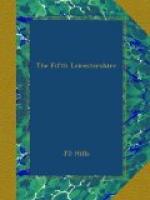From the southern end of Zillebeke village two roads ran to the front line. One, almost due South, kept close to the railway and was lost in the ruins of Zwartelen village on “Hill 60”; the other, turning East along a ridge, passed between Sanctuary and Armagh Woods, and crossed our front line between the “A” and “B” trenches, the left of our new sector. The ridge, called Observatory, on account of its numerous O.P.’s, was sacred to the Gunners, and no one was allowed to linger there, for fear of betraying these points of vantage. Beyond it was a valley, and beyond that again some high ground N.E. of the hill, afterwards known as Mountsorrel, on account of Colonel Martin’s Headquarters, which were on it. The line ran over the top of this high ground, which was the meeting place of the old winter trenches (numbered 46 to 50) on the right, and, on the left the new trenches “A,” “B,” etc., built for our retirement during the 2nd Battle. The 5th Division held the old trenches, we relieved the Sherwood Foresters in the new “A1” to “A8,” with three companies in the line and only one in support. The last was near Battalion Headquarters, called Uppingham in Colonel Jones’ honour, which were in a bank about 200 yards behind the front line. Some of the dug-outs were actually in the bank, but the most extraordinary erection of all was the mess, a single sandbag thick house, built entirely above ground, and standing by itself, unprotected by any bank or fold in the ground, absolutely incapable, of course, of protecting its occupants from even an anti-aircraft “dud.”
We soon discovered during our first tour the difference between the Salient and other sectors of the line, for, whereas at Kemmel we were rarely shelled more than once a day, and then only with a few small shells, now scarcely three hours went by without some part of the Battalion’s front being bombarded, usually with whizz-bangs. The Ypres whizz-bang, too, was a thing one could not despise. The country round Klein Zillebeke was very close, and the Boche was able to keep his batteries only a few hundred yards behind his front line, with the result that the “Bang” generally arrived before the whizz. “A6” and “A7” suffered most, and on the 1st July Captain T.C.P.




